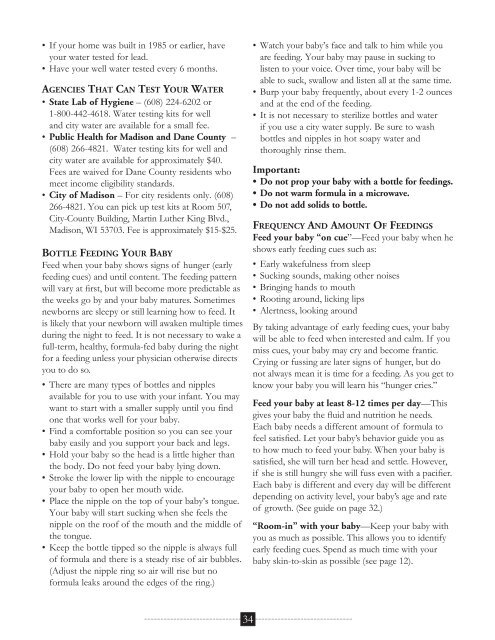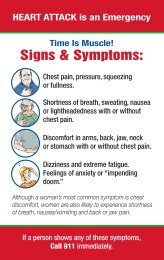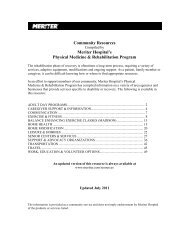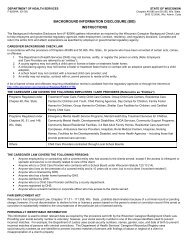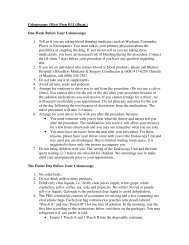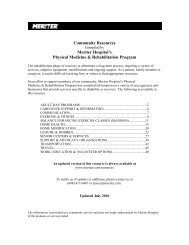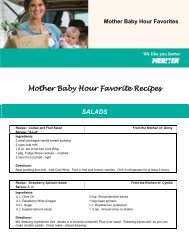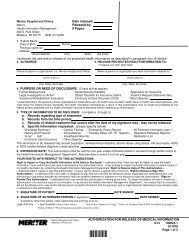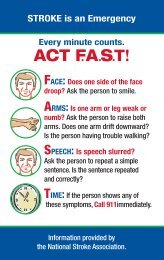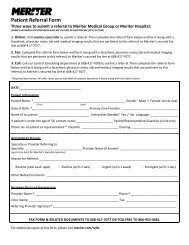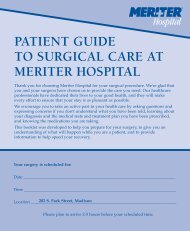A Guide To Your New Family's First Weeks - Meriter Health Services
A Guide To Your New Family's First Weeks - Meriter Health Services
A Guide To Your New Family's First Weeks - Meriter Health Services
You also want an ePaper? Increase the reach of your titles
YUMPU automatically turns print PDFs into web optimized ePapers that Google loves.
• If your home was built in 1985 or earlier, have<br />
your water tested for lead.<br />
• Have your well water tested every 6 months.<br />
Agencies That Can Test <strong>Your</strong> Water<br />
• State Lab of Hygiene – (608) 224-6202 or<br />
1-800-442-4618. Water testing kits for well<br />
and city water are available for a small fee.<br />
• Public <strong>Health</strong> for Madison and Dane County –<br />
(608) 266-4821. Water testing kits for well and<br />
city water are available for approximately $40.<br />
Fees are waived for Dane County residents who<br />
meet income eligibility standards.<br />
• City of Madison – For city residents only. (608)<br />
266-4821. You can pick up test kits at Room 507,<br />
City-County Building, Martin Luther King Blvd.,<br />
Madison, WI 53703. Fee is approximately $15-$25.<br />
Bottle Feeding <strong>Your</strong> Baby<br />
Feed when your baby shows signs of hunger (early<br />
feeding cues) and until content. The feeding pattern<br />
will vary at first, but will become more predictable as<br />
the weeks go by and your baby matures. Sometimes<br />
newborns are sleepy or still learning how to feed. It<br />
is likely that your newborn will awaken multiple times<br />
during the night to feed. It is not necessary to wake a<br />
full-term, healthy, formula-fed baby during the night<br />
for a feeding unless your physician otherwise directs<br />
you to do so.<br />
• There are many types of bottles and nipples<br />
available for you to use with your infant. You may<br />
want to start with a smaller supply until you find<br />
one that works well for your baby.<br />
• Find a comfortable position so you can see your<br />
baby easily and you support your back and legs.<br />
• Hold your baby so the head is a little higher than<br />
the body. Do not feed your baby lying down.<br />
• Stroke the lower lip with the nipple to encourage<br />
your baby to open her mouth wide.<br />
• Place the nipple on the top of your baby’s tongue.<br />
<strong>Your</strong> baby will start sucking when she feels the<br />
nipple on the roof of the mouth and the middle of<br />
the tongue.<br />
• Keep the bottle tipped so the nipple is always full<br />
of formula and there is a steady rise of air bubbles.<br />
(Adjust the nipple ring so air will rise but no<br />
formula leaks around the edges of the ring.)<br />
• Watch your baby’s face and talk to him while you<br />
are feeding. <strong>Your</strong> baby may pause in sucking to<br />
listen to your voice. Over time, your baby will be<br />
able to suck, swallow and listen all at the same time.<br />
• Burp your baby frequently, about every 1-2 ounces<br />
and at the end of the feeding.<br />
• It is not necessary to sterilize bottles and water<br />
if you use a city water supply. Be sure to wash<br />
bottles and nipples in hot soapy water and<br />
thoroughly rinse them.<br />
Important:<br />
• Do not prop your baby with a bottle for feedings.<br />
• Do not warm formula in a microwave.<br />
• Do not add solids to bottle.<br />
Frequency And Amount Of Feedings<br />
Feed your baby “on cue”—Feed your baby when he<br />
shows early feeding cues such as:<br />
• Early wakefulness from sleep<br />
• Sucking sounds, making other noises<br />
• Bringing hands to mouth<br />
• Rooting around, licking lips<br />
• Alertness, looking around<br />
By taking advantage of early feeding cues, your baby<br />
will be able to feed when interested and calm. If you<br />
miss cues, your baby may cry and become frantic.<br />
Crying or fussing are later signs of hunger, but do<br />
not always mean it is time for a feeding. As you get to<br />
know your baby you will learn his “hunger cries.”<br />
Feed your baby at least 8-12 times per day—This<br />
gives your baby the fluid and nutrition he needs.<br />
Each baby needs a different amount of formula to<br />
feel satisfied. Let your baby’s behavior guide you as<br />
to how much to feed your baby. When your baby is<br />
satisfied, she will turn her head and settle. However,<br />
if she is still hungry she will fuss even with a pacifier.<br />
Each baby is different and every day will be different<br />
depending on activity level, your baby’s age and rate<br />
of growth. (See guide on page 32.)<br />
“Room-in” with your baby—Keep your baby with<br />
you as much as possible. This allows you to identify<br />
early feeding cues. Spend as much time with your<br />
baby skin-to-skin as possible (see page 12).<br />
34


